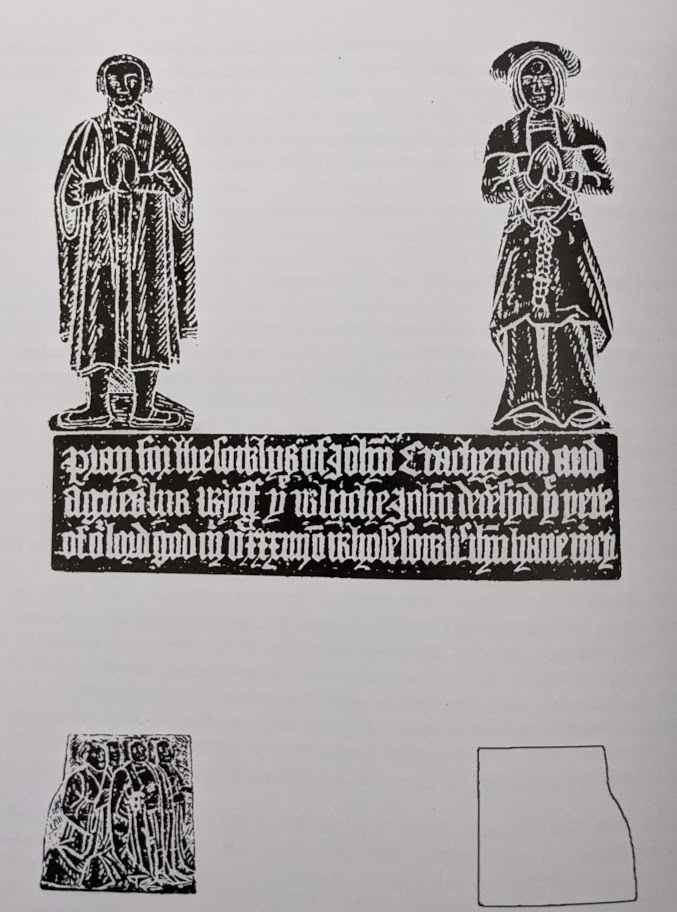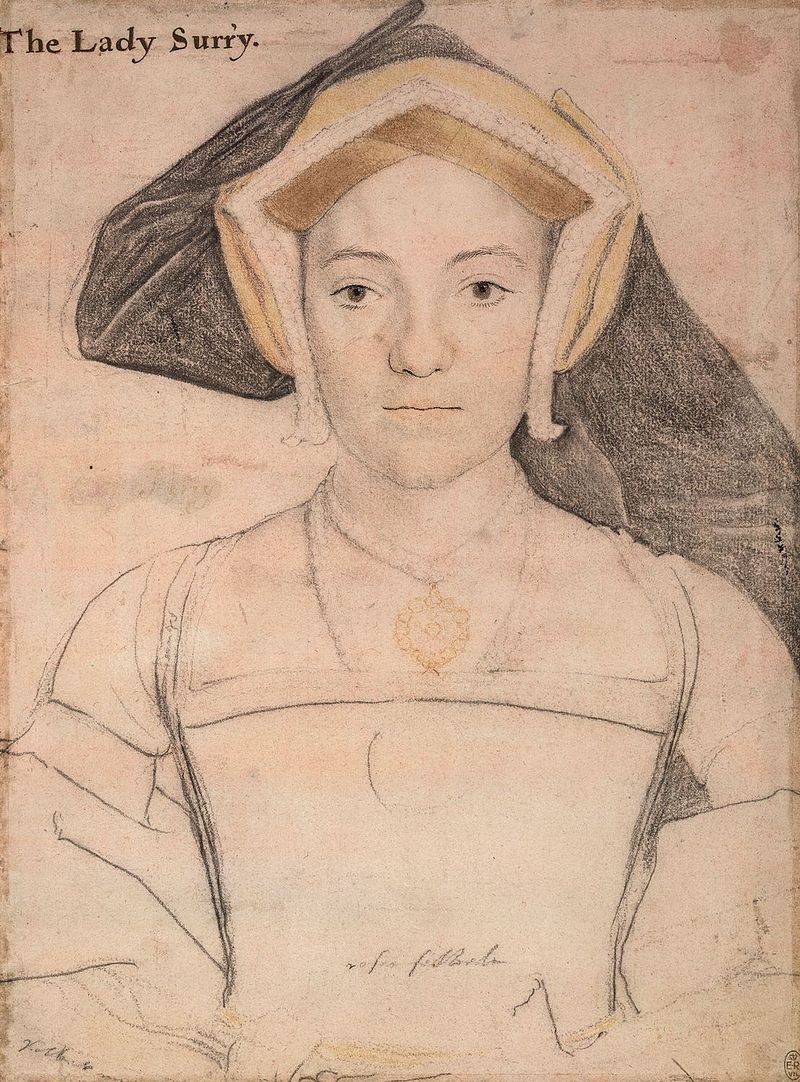- Home
- /
- History
- /
- The Crachrode family of...
- /
- John Crachrode (d1534) and...

John and his family were commemorated by a brass at the church in Toppesfield, which featured in the Essex Archaeological Society transactions back in 1898.
Pray for the sowlys of John Cracherood and Agnes his wyff the whiche John decesyd the yere of or Lord God mvccciiii on whose sowlis ihn have mercy.
John died in 1534, after he and his wife had four sons and four daughters. The brass showing the sons can still be seen, but the one showing the daughters is lost. The Visitation tells us only the name of one son, William, on whom more later. There’s a John Cracherood buried at Toppesfield in 1577 who doesn’t fit in with the tree as I’ve managed to reconstruct it, so I wonder if he might be one of the elusive missing sons.
Though the brass of the daughters is lost, we do at least know their names, at least, as far as the visitation relates. They were:
- Ellen, who married William Hunt of Gosfield
- Joanne, who married John Tendringe of Borham
- Julian, who married a gentleman by the surname Lee
- Jane, who married Peter Fitche of Writtle.
Unfortunately, I don’t know anything more about Julian and Jane. I can’t find a will for Peter Fitche, and as the earliest parish register for Writtle is lost, I can’t find him or family in it. And neither can I find any Fitches mentioned under Writtle in Morant. And while he appears in the Crachrode’s Visition, I couldn’t find a Peter under the Fitch family’s entry. That said… the Mannocks might provide a clue as Francis Mannock (1523-1591) married a woman called Fitch. A trawl through lots of Fitch wills might eventually find him, perhaps.
Julian is even harder to pin down as her husband comes with neither a first name or an abode, beyond “Essex”. But I can’t see a Julian Lee in parish register transcriptions. As with Peter Fitch, a trawl through Lee wills might help.
Joan Crachrode and John Tendring
Joanne – or Joan as she sometimes appears in documents – married John Tendring of Boreham probably before 1531.[1]This is based on Morant telling us that John Tendring died in 1552, and that his oldest son, Thomas, was 21 at the time. So if Thomas was Joan’s son, and Joan wasn’t John’s second … Continue reading There is a lot to be said about the Tendrings, so they will no doubt get their own space on this website before long.
John Tendring’s will – or at John Tenderyng’s – is held at ERO, in which he mentions nine children: his five sons Valentine, John, Thomas, George and William.[2]The 1558 Visitation doesn’t mention George, and numbers the sons as Thomas the eldest, then John, Valentine and William. In his will, John says that George is his second son, and William his … Continue reading He mentions his daughters Alice and Bennett, who presumably weren’t married at the time he wrote his will in 1551, and his two sons-in-law – Richard Hubberd and Harry Dore. Other sources show that it was John and Joan’s daughter Margaret who married Richard Hubbard (then John Thurston of Frinton, and finally, in 1574, Ralph Starling of Dedham – my ancestor), and Mary who married Henry Dore. John also mentioned his brother William, and William’s son John, as well as his brother-in-law William Cracherood (who died in 1586), and his son Thomas.
Morant records that John died in 1552, when his eldest son, Thomas, was 21.[3]Morant’s source is an inquisition post mortem, which is now held at The National Archives in Kew. It amazes me how Morant managed to find all this information.
Ellen Crachrode and William Hunt
Ellen married William Hunt, a coroner, some time in the early 1530s or perhaps the late 1520s. They were once commemorated in a brass at the church in Gosfield, which said that the couple had had eleven children – I’ve managed to identify ten of them.
William wrote his will on 11 August 1552. He was buried two days later, so wrote his will on his deathbed. He died around the same time as Ellen’s brother-in-law, John Tendring – I don’t know if this suggests there was an epidemic at large at the time. All of his children were under 24 at the time. He mentions five sons – the eldest being Henry, followed by Thomas, William, Edward (baptised 1538) and Robert (1544), then his daughters Agnes, Anne (1540), Margery (1543), Ellen (or Elyn, as the name appears in the will – baptised 1546), and Mary (1548).[4]The children, from Edward to Mary, appear in Gosfield’s parish register. In fact, the very first baptism recorded in the register is that of Edward.
And what about the tenth child? This was Sigismund. He was presumably born before 1538 as his baptism doesn’t appear in the register, but he was buried in Gosfield in August 1551, dying just a year before his father.
Ellen lived another twenty-six years after her husband’s death. She was buried in Gosfield on 12 September 1578. As her husband had done, she wrote her will on her deathbed – just six days before her burial. It appears that none of her children had died in the intervening years – some of her children had married.
In 1573, her son Henry had married Jane de Vere, daughter of Aubrey de Vere (second son of John de Vere the 15th Earl of Oxford). Aubrey’s sister, Elizabeth (d 1565) was the wife of Thomas Darcy, 1st Baron of Chich, which ties them in with the Pyrtons and the Mannocks.[5]Their daughter, Constance Darcy, married Edmund Pyrton (1530-1609), and one of the Pyrtons married a man called William Mannock. And in 1576 Jane’s sister, Bridget, married Thomas Crachrode – more on them later.
Aubrey’s sister Frances married Henry Howard, Earl of Surrey, a man executed in 1547 by a paranoid Henry VIII who thought he was going to try to use his noble ancestry to seize the throne. Frances was drawn by Holbein in about 1535 – I find Holbein’s portraits fascinating as they’re so realistic, almost photographlike. I wonder how much Jane and Bridget resembled their aunt Frances?
Ellen Hunt’s daughter Anne had married John Whitbread, her daughter Mary had married Robert Coe, and her daughter Ellen had married Thomas Smyth.
Henry Hunt continued to live in Gosfield, which isn’t surprising after inheriting his father’s house there. He wrote his will in 1612, and it was proved two years later – but there doesn’t appear to be a burial for him recorded at Gosfield or anywhere nearby. He mentions his cousin John Whitbread of Writtle in his will, which could well be his brother-in-law. And who knows, maybe that might even provide a clue for identifying his uncle – Peter Fitche of Writtle, who had married Ellen’s sister Julian.
Footnotes
| ↑1 | This is based on Morant telling us that John Tendring died in 1552, and that his oldest son, Thomas, was 21 at the time. So if Thomas was Joan’s son, and Joan wasn’t John’s second wife, then Joan and John would’ve married in or before 1531. |
|---|---|
| ↑2 | The 1558 Visitation doesn’t mention George, and numbers the sons as Thomas the eldest, then John, Valentine and William. In his will, John says that George is his second son, and William his youngest. |
| ↑3 | Morant’s source is an inquisition post mortem, which is now held at The National Archives in Kew. It amazes me how Morant managed to find all this information. |
| ↑4 | The children, from Edward to Mary, appear in Gosfield’s parish register. In fact, the very first baptism recorded in the register is that of Edward. |
| ↑5 | Their daughter, Constance Darcy, married Edmund Pyrton (1530-1609), and one of the Pyrtons married a man called William Mannock. |

